- More than 2 years ago
A smoother Western hemisphere, mysterious material unearthed by impacts, magnesium in the exosphere and a dynamic magnetic field are some of the newly identified features of Mercury revealed by MESSENGER during its second flyby of one of the least-explored planets.
The spacecraft MESSENGER skirted Mercury’s surface on October 6 in the second of three scheduled flybys before ultimately entering the planet’s orbit in 2011. During the second flyby, MESSENGER captured over 1,200 images, including never-before-seen views of the Western hemisphere of the planet closest to the sun. Scientists unveiled their findings in an October 29 press briefing at NASA headquarters in Washington, D.C.
This new data, when combined with images collected from MESSENGER’s first flyby and data from Mariner 10 — the only other spacecraft to image Mercury in the 1970s — surveys about 95 percent of the planet, giving researchers a global view of the body.
Topographical data from MESSENGER’s powerful laser altimeter yielded one of the biggest surprises of the second flyby: Scientists learned that the Western hemisphere is about 30 percent smoother than the Eastern hemisphere. This difference could have been caused by a global geological event sometime during Mercury’s early life. “That’s something we’re excited to follow up on,” said MESSENGER coinvestigator Maria Zuber, an MIT geophysicist, during the press conference.
MESSENGER also sent back information on new surface features, one of which is a peak in the wrinkle ridge. This mountainous range is thought to have formed during a major contraction that happened when Mercury’s hot iron core cooled. The newly discovered peak is 600 meters high, nearly twice the size of the tallest ridges measured on Mars, although Zuber cautions that, as of now, scientists are still working with a very small data set.
To investigate the makeup of Mercury’s crust, scientists merged high-resolution visual and near-infrared photographs to create images that showed, in great detail, compositional variations. Colors that would appear dull to naked human eyes were transformed into intense blues and yellows. The color images identified brilliant blue regions on the surface of Mercury, consisting of material thought to have once been buried. Impacts may have brought this material to the surface, but surprisingly, craters of equal size elsewhere do not have the material around them, suggesting the blue material is concentrated in splotches underneath the surface.
“The bottom line is that the crust is very heterogeneous,” explains MESSENGER coinvestigator Mark Robinson of Arizona State University in Tempe. Because the flyby was too brief to engage all of MESSENGER’s science tools, scientists will have to wait until MESSENGER is in orbit before they know the makeup of the blue stuff. Robinson says that he is looking forward to getting MESSENGER into orbit, so that “I can stop saying ‘blue material.’ ”
MESSENGER was also able to probe Mercury’s tenuous atmosphere, called an exosphere, and found that two elements known to exist in its tail-shaped region, sodium and calcium, were not distributed evenly. This unequal distribution could provide clues about events on Mercury’s surface that kick these elements into the exosphere. The flyby also detected magnesium in the exosphere for the first time, says Ronald Vervack Jr., MESSENGER scientist at the Johns Hopkins University Applied Physics Laboratory in Laurel, Md.
Scientists were surprised by MESSENGER’s findings on the magnetosphere. Data beamed back revealed that the solar wind affects Mercury’s magnetic field to a much greater extent than previously thought. The craft’s first flyby saw solar winds blowing north and exerting a small but noticeable effect on the planet’s magnetosphere. This time around, MESSENGER caught the southbound solar wind pushing Mercury’s magnetosphere back toward the planet with surprising strength in what Sean Solomon, principal investigator for MESSENGER at the Carnegie Institution for Science in Washington, D.C., calls an “extreme example in the solar system.” Brian Anderson, MESSENGER deputy project scientist at Johns Hopkins’ APL, said “I have never seen a magnetic field pointed this strongly at a planet.”
In addition to uncovering new visions of Mercury, this flyby also provided MESSENGER with a critical gravity assist, a maneuver required to keep the craft on course to be the first to enter Mercury’s orbit, in 2011, where it will remain for one Earth year.








